Asparagus is a healthy delicious superfood that is ready for us in the spring. When it is asparagus season that means it is spring! It is a very special vegetable that is so tasty and can be expensive too.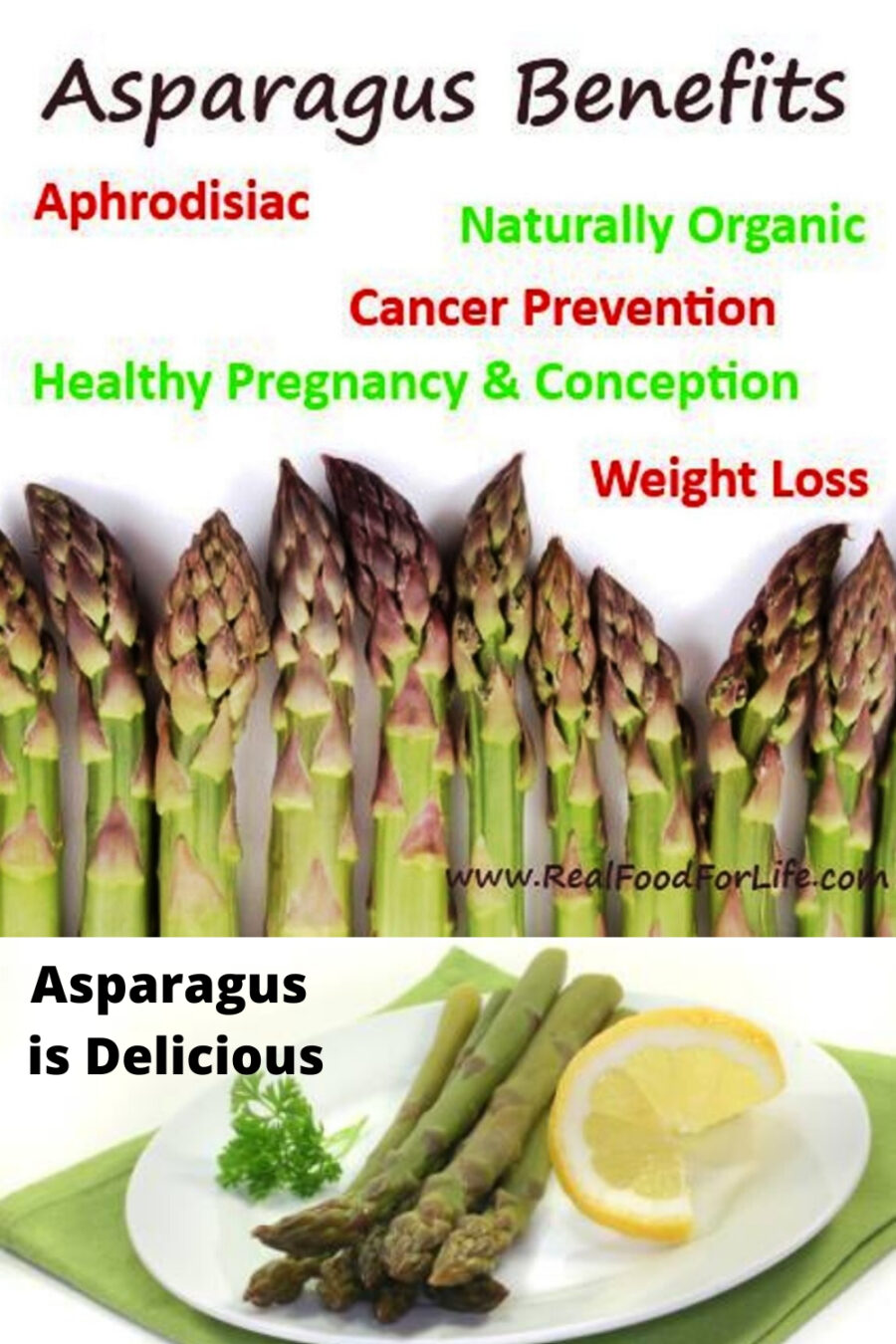
Asparagus Superfood Health Benefits
1. Feeds Friendly Bacteria
One of the few vegetables containing a carbohydrate called inulin. Inulin promotes the growth and activity of these friendly bacteria in the intestines making it difficult for unfriendly bacteria to grow.
2. Helps Fight Cancer
Asparagus has senecio asperulus and laricinus in it which has been found to be effective in fighting prostate and breast cancer cells according to a study that is not conclusive as some of it was done on mice.
Glutathione is an important anti-carcinogen and asparagus has a high amount in it. Other foods high in glutathione are peppers, carrots, avocados, squash, spinach, and melons.
Glutathione is the most potent anti-oxidant available. Glutathione also makes asparagus a great cleanser for the body! We use it in our Spring Cleanse.
“Asparagus is the best at de-bloating, since it helps flush out the bad stuff.” ~ David Kirsch
3. Helpful for Diabetics
This is another benefit of having a high quantity of glutathione is it may be helpful for diabetics.
“Insulin resistance can result in the development of type 2 diabetes. The production of insulin causes the body to move glucose (sugar) from the blood and into cells that use it for energy. A small 2018 study indicates that people with insulin resistance tend to have lower glutathione levels.” ~ Medical News Today
4. Help with a Hangover
Of course it is important if you have a hangover to drink lots of water and get rest.
Researchers say amino acids and minerals in asparagus extract may ease hangovers and protect liver cells against the toxins in alcohol.
“These results provide evidence of how the biological functions of asparagus can help alleviate alcohol hangover and protect liver cells.” said lead researcher B.Y. Kim, Institute of Medical Science and Jeju National University in South Korea.
5. Naturally Organic
Because this vegetable grows so quickly the need for pesticides and other chemicals is reduced. It is on the Environmental Working Group’s Clean 15 list of fruits and vegetables with the lowest occurrence of pesticides. Of course, you can still eat organic for that little bit of extra nutrition and buy organic to support the cause.
6. Helps Treat Urinary Problems that Create Kidney and Bladder Stones
It is a good source of the amino acid asparagine, which serves as a natural diuretic This increased urination releases fluid and helps rid the body of excess salts.
“When women are not urinating enough, they can get a UTI. It’s possible that a diet rich in asparagus could prevent these painful infections from developing, since going to the bathroom more frequently can help move bad bacteria out of the urinary tract.”~ Keri Gans, RD a nutrition consultant in New York and author of The Small Change Diet.
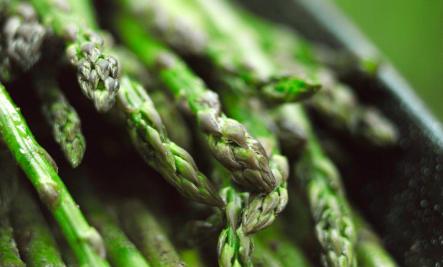
7. Alkalizes the Body
Like almost all vegetables, it helps to balance out, what for most individuals is an overly acidic diet. Being more alkaline creates greater energy, beautiful skin, and a stronger immune system and less degenerative diseases.
8. Easy For Weight Loss
A serving has only 27 calories and is full of nutrients. With its high fiber content, and low glycemic index it is considered a smart carb. Too bad they haven’t invented asparagus chips or snacks. It would be so much better than junk food or fries.
9. Excellent Source of Folacin
Folacin has been shown to help in the prevention of neural tube defects that cause paralysis and death.
“Folic acid is essential for women who are planning on getting pregnant, since it can help protect against neural tube defect,” ~ Keri Gans, RD a nutrition consultant in New York and author of The Small Change Diet.
10. Traditional Aphrodisiac
Many cultures traditionally consider asparagus to be a natural aphrodisiac. Although there is not a lot of research to back this up, it’s close ‘cousin’ Shatavari (also part of the asparagus family) is called “she who possesses 100 husbands” for good reason. Satavari is also known within the Ayurvedic health system to feed both male and female reproductive tissues and has been used to treat PMS and menopause symptoms for centuries. The only research I could find was on rats!
Please Note
Some people have strong-smelling urine after eating asparagus, sulfur-like odor resulting from the digestion of certain amino acids. And some people are genetically unable to detect the smell!
Asparagus Nutrition
- It is a nutritionally balanced vegetable full of lots of nutrients making it a superfood!
- A very good source of vitamin K, the B vitamin folate, vitamin C, and vitamin A.
- It is filled with B vitamins (B1, B2, B3, and B6).
- Excellent source of folacin.
- Full of the minerals manganese, copper, phosphorus, potassium, and selenium.
- Good source of fiber (3 grams per 5.3 oz. serving).
- It even has some protein (3 grams per 5.3 oz. serving).
- It contains ‘No Cholesterol or Fat’.
- Very low in sodium.
- Less than 4 calories per spear.
Go to Nutrition Data for more details.
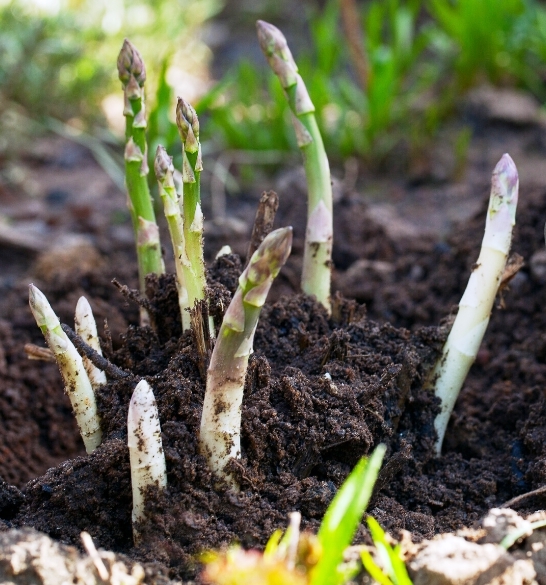
Trivia and Interesting Facts About Asparagus Superfood
- Historically it was considered as an aphrodisiac, probably because of its phallic shape.
- White asparagus is regular asparagus, just covered from the sun so green chlorophyll doesn’t develop.
- It can grow up to 10 inches in a 24-hour period!
- “The longest asparagus measured 351.7 cm (138.5 in) when it was presented by Harry and Carson Willemse (both Canada) at the Port Elgin Pumpkinfest, Ontario, Canada on 2 October 2004.” ~ Guinness World Records
- Did you know that asparagus is a member of the lily family?
- Besides being yummy the asparagus plant is very long-lived, lasting up to 15 years!
- “Asparagus Capital of the World” in Schwetzingen, Germany holds its annual asparagus festival in the first week of May. The person who grows the heaviest stalk is named Spargel King or Queen. Also, asparagus chefs compete to create the best recipes.
- All commercially grown must still be harvested by hand.
- Has many medicinal properties according to the ancient Romans.
“Keep bees and grow asparagus, watch the tides and listen to the wind instead of the politicians …if you want to live the good life.” – Miriam Waddington, Driving Home ‘Advice to the Young’.
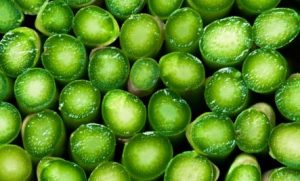
History
- It was first cultivated 2,500 years ago by the Greeks.
- The name comes from a Greek word meaning stalk or shoot.
- A second-century physician, Galen, described asparagus as “cleansing and healing.”
- The Romans grew it in high walled courtyards and during their conquests spread it to the Gauls, Germans, Britons and from there, the rest of the world.
- Ancient Egyptians, Greeks, and Romans liked this vegetable as much as we do and ate it when in season.
Buying Asparagus
- Best to buy it fresh at the farmer’s market if you can.
- Choose firm, bright green spears with closed and dry tips. Asparagus can be found both thick or thin but it is best if you choose one or the other when cooking so the spears will cook at the same rate.
- Avoid shriveled or smelly asparagus, and if the woody bottom ends of the stalks exceed 15% of the total length of the spears it is likely to be tough.
- It is fragile, damages easily, and dries out quickly; best to eat it as soon as possible.
- Gently squeeze the bunch of asparagus, if it squeaks, it’s fresh.
- You may think the thin stalks are more tender but that is not the case; often jumbo stalks are more tender and succulent than their pencil-thin counterparts.
How to Store
- Cut off the bottom inch of the stalks.
- Wrap the freshly cut stems in a wet paper towel.
- Place it in a plastic bag.
- It will last in the refrigerator for up to 3 days.
- For a longer life; stand asparagus upright (cut end down) in water, and cover it with a plastic bag to retain moisture.
Good asparagus needs minimal treatment and is best eaten with few other ingredients. ~ Yotam Ottolenghi
Tips for eating or cooking
- The easiest way to get asparagus into your diet is to eat it raw; simply cut it up and add it to your salads.
- Another simple thing to do is to just steam it for a few minutes and it is done. Careful not to overcook it so you do not lose the nutrients.
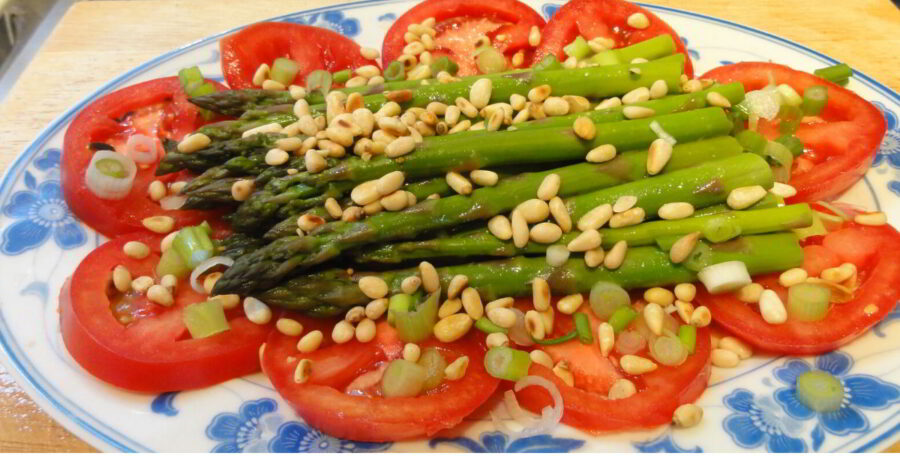
5 Great Asparagus Recipes
Asparagus Tomato Salad This luxurious asparagus tomato salad was enjoyed so much the first time I created the recipe so I never stopped serving it.
Asparagus With Lemon Juice: If you like asparagus than you will enjoy this recipe with lemon. You will love how easy it is to make this healthy recipe that is a delicious addition to any meal.
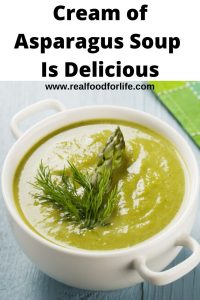 Cream of Asparagus Soup – This cream of asparagus soup is dairy-free and gluten-free. It is delicious and simple to make. A creamy soup that is vegan is not so common and that makes this soup extra special.
Cream of Asparagus Soup – This cream of asparagus soup is dairy-free and gluten-free. It is delicious and simple to make. A creamy soup that is vegan is not so common and that makes this soup extra special.
Baked Asparagus If you have a bit more time, this has an extra heavenly tasty recipe to try.
White Bean and Asparagus Stew This contains three superfoods, asparagus, seaweed, and Stevia. I created this White Bean and Asparagus Stew recipe out for the first time on two dinner guests. That was rather brave! They were good friends, and you never know how some people react to beans. Sometimes people get gas unless your take the proper steps. I had taken all the precautions though, and they loved it! They explained it was very tasty.
100+ Superfoods
Learn more about some of the healthiest vegetarian foods you will always want to have in your pantry or growing on your deck.
READ: Superfoods – Over 100 of the Healthiest Foods You Should Have in Your Diet and learn more about the variety of Superfoods we think you should have in your diet.


Onions, shallots, artichokes
The lily family is asparagus, chives, garlic, leel(aster), onion, and sparsparilla
that is leek
Gosh, it is looking like George is going to be the winner unless anyone can come up with more…there is one more that I can think of. 🙂 Must say I had not heard of sparsparilla, then I realized it was a spelling thing so the name is sarsaparilla.
I found out that Native Amazonian people have used sarsaparilla to improve their virility and to treat problems associated with menopause.
Caution though as this is a medicinal herb:
Sarsaparilla can cause nausea and kidney damage; large dosages taken over long periods of time must be avoided at all costs.
I don’t know too much about the veg but my answer is
onion , garlic, leek, & chives.
You are right John but I have to say that George did discover more then you did so it looks like he is the winner of the ‘Vegetable Smartie’ contest unless anyone comes up with the one that has not been found out yet……good thing I am not in the running. 🙂
Okay, I guess I better say the one lily family food that is missing….lily bulbs.
Lilium bulbs are starchy and edible as root vegetables, although bulbs of some species may be very bitter. Their texture and taste are similar to a potatoes.
Caution: Many varieties of lily are toxic to cats, causing acute renal failure even in small amounts.
When you decide to cook up some lily bulbs make sure they are the edible type and the best way to do that is to go to a Chinese vegetable store where they sell them.
my grandfather is fond of ayurvedic medicines coz he know that it works well”`’
The growth of Asparagus has a long history going back to no less than 2000 years when the Egyptians grew it for its wellbeing and restorative properties. It additionally has associations with Ancient Rome and Greece.